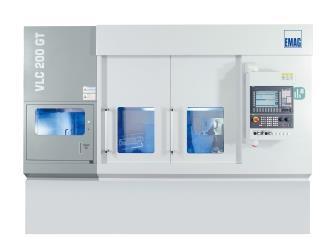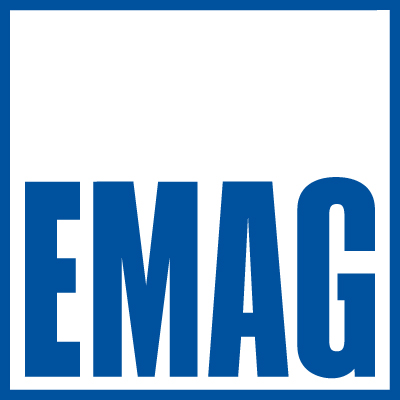
It is no secret that e-mobility is a growing market. A current study by the consulting firm Strategy Analytics, predicts the production output of “electric vehicles” will increase to 25% of the global market by 2025. It should be noted that the study uses “electric” as an umbrella term that covers all aspects of e-mobility, i.e. hybrids, fuel cell drives, and pure electric vehicles, and that the markets are highly heterogeneous. It is expected that 50% of the production will take place in China, and the other 50% will be throughout the rest of the world.
Heterogeneous markets means multiple manufacturers, even more models, and diverse drive concepts. In addition, about three quarters of vehicles will continue to have traditional combustion engines. This puts production planners and automotive industry suppliers in a difficult situation: How do you manage this product diversity and increasing production volumes?
For many years, EMAG has been providing answers to these questions with a broad range of production solutions for components used mainly in powertrain applications.
EMAG’s VLC series covers a broad range of machining technologies: turning, drilling, milling, gear hobbing, hard and soft machining—basically everything that is required to build comprehensive manufacturing lines. “VLC machines enable us to cover the entire process chain for the manufacturing of transmission components, from blanks to finished parts,” explains Peter Loetzner, president and CEO EMAG LLC. “Customers benefit from the unified design of our machines—consistent transfer heights and an integrated pick-up automation system that make it easy to connect machines.”
The pick-up automation system, which revolutionized the market almost 30 years ago, is the platform for the success of EMAG machines. Every machine in the VLC series features a parts storage area for raw and finished parts, as well as a working spindle that is automatically loaded and unloaded from this unit. It guarantees minimized non-productive times and high efficiency.
“Of course, these qualities are shared by the VLC 200 GT, a combined turning and grinding machine that we developed specifically for the hard machining at the end of the process chain,” Loetzner adds.
The VLC 200 GT was developed primarily with a focus on transmission gears and was first launched in 2016. “Because of their large production numbers and high quality requirements, transmission gears are ideal parts to be machined on the VLC 200 GT,” Loetzner explains. “When we analyzed the machining process, we found that we could perform the entire machining process in a single clamping operation.” To achieve this, EMAG combines the processes of hard turning and grinding. The shoulder and the bore are hard-turned first. Only a few micrometers of material is then left to be removed from the transmission gear. This ensures a much shorter grinding process using aluminum oxide or CBN grinding wheels, which saves costs in two ways: through lower tool costs resulting in a lower unit cost, and through faster cycle times. The machining quality also benefits from the combination of turning and grinding: When there is only a small amount of material remaining to be ground away after turning, the specifications for the grinding wheel can be based more precisely on the end quality required—as a result, surfaces with an average peak-to-valley height Rz of less than 1.6 micrometers can be reliably achieved with the VLC 200 GT.
Transmission gears will continue to be among the most commonly manufactured parts in the automotive industry well beyond the year 2025. However, with the increased electrification of the power train, certain older transmission designs are having a rebirth. Peter Loetzner explains: “We are seeing a trend toward CVT transmissions. This is mainly due to the high efficiency of this design, whose smooth adjustment of the gear ratio without any interruption of the traction force ensures the optimal use of the supplied energy and therefore a low fuel consumption. Applied to hybrid vehicles, this means greater ranges from a single battery charge, enabling for example the fully electric operation in city traffic for an entire day.”
The continuously variable transmission results in especially comfortable driving, and is based on an intelligent design concept that does not use any toothed gears. Instead, power is transmitted via a steel belt or a lamellar chain which run around two shafts with conical disks. The quality of the components is extremely important. This is why the precision hard-machining is usually done in a multi-stage process on different turning and grinding machines. Especially in hard machining, production planners have little tolerance for error because the initial cost for hardened blanks is already high. EMAG took to the task with delight.
The machining area of the VLC 200 GT can be configured based on the application. Available options include internal and external spindles, block toolholders, or EMAG’s proven 12-post turret. “The machine’s flexibility allows us to use it for CVT pulley disks, in addition to transmission gears,” Loetzner explains further.
EMAG has equipped the VLC 200 GT with an external grinding spindle in addition to the tool turret – again, a combination of hard turning and grinding. “This combination of processes allows us to optimally configure the grinding wheel for the surface of the CVT disk – all the other surfaces and bore holes can be made to the required specs by turning alone,” Loetzner says. This results in lower tool costs and cycle times due to reduced wear on the grinding wheel, which means that it needs to be dressed less often. When it does need dressing, the VLC 200 GT features a separate diamond-coated dressing spindle. “With its separate rotating dressing system and gap control monitoring, the machine is perfectly equipped to exploit the advantages of CBN grinding,” Loetzner emphasizes. To ensure sustained process reliability and high machining quality, the integrated measuring pin is used to check the diameter and length of the clamped component at the end of the process. Corrections are made as necessary. Operator comfort and ease of access were also important priorities for EMAG's developers: Large doors provide easy access to the machining area. Tools and clamping devices can be changed quickly and conveniently.
Contact Details
Related Glossary Terms
- aluminum oxide
aluminum oxide
Aluminum oxide, also known as corundum, is used in grinding wheels. The chemical formula is Al2O3. Aluminum oxide is the base for ceramics, which are used in cutting tools for high-speed machining with light chip removal. Aluminum oxide is widely used as coating material applied to carbide substrates by chemical vapor deposition. Coated carbide inserts with Al2O3 layers withstand high cutting speeds, as well as abrasive and crater wear.
- cubic boron nitride ( CBN)
cubic boron nitride ( CBN)
Crystal manufactured from boron nitride under high pressure and temperature. Used to cut hard-to-machine ferrous and nickel-base materials up to 70 HRC. Second hardest material after diamond. See superabrasive tools.
- dressing
dressing
Removal of undesirable materials from “loaded” grinding wheels using a single- or multi-point diamond or other tool. The process also exposes unused, sharp abrasive points. See loading; truing.
- gang cutting ( milling)
gang cutting ( milling)
Machining with several cutters mounted on a single arbor, generally for simultaneous cutting.
- grinding
grinding
Machining operation in which material is removed from the workpiece by a powered abrasive wheel, stone, belt, paste, sheet, compound, slurry, etc. Takes various forms: surface grinding (creates flat and/or squared surfaces); cylindrical grinding (for external cylindrical and tapered shapes, fillets, undercuts, etc.); centerless grinding; chamfering; thread and form grinding; tool and cutter grinding; offhand grinding; lapping and polishing (grinding with extremely fine grits to create ultrasmooth surfaces); honing; and disc grinding.
- grinding machine
grinding machine
Powers a grinding wheel or other abrasive tool for the purpose of removing metal and finishing workpieces to close tolerances. Provides smooth, square, parallel and accurate workpiece surfaces. When ultrasmooth surfaces and finishes on the order of microns are required, lapping and honing machines (precision grinders that run abrasives with extremely fine, uniform grits) are used. In its “finishing” role, the grinder is perhaps the most widely used machine tool. Various styles are available: bench and pedestal grinders for sharpening lathe bits and drills; surface grinders for producing square, parallel, smooth and accurate parts; cylindrical and centerless grinders; center-hole grinders; form grinders; facemill and endmill grinders; gear-cutting grinders; jig grinders; abrasive belt (backstand, swing-frame, belt-roll) grinders; tool and cutter grinders for sharpening and resharpening cutting tools; carbide grinders; hand-held die grinders; and abrasive cutoff saws.
- grinding wheel
grinding wheel
Wheel formed from abrasive material mixed in a suitable matrix. Takes a variety of shapes but falls into two basic categories: one that cuts on its periphery, as in reciprocating grinding, and one that cuts on its side or face, as in tool and cutter grinding.
- hard turning
hard turning
Single-point cutting of a workpiece that has a hardness value higher than 45 HRC.
- milling
milling
Machining operation in which metal or other material is removed by applying power to a rotating cutter. In vertical milling, the cutting tool is mounted vertically on the spindle. In horizontal milling, the cutting tool is mounted horizontally, either directly on the spindle or on an arbor. Horizontal milling is further broken down into conventional milling, where the cutter rotates opposite the direction of feed, or “up” into the workpiece; and climb milling, where the cutter rotates in the direction of feed, or “down” into the workpiece. Milling operations include plane or surface milling, endmilling, facemilling, angle milling, form milling and profiling.
- tolerance
tolerance
Minimum and maximum amount a workpiece dimension is allowed to vary from a set standard and still be acceptable.
- turning
turning
Workpiece is held in a chuck, mounted on a face plate or secured between centers and rotated while a cutting tool, normally a single-point tool, is fed into it along its periphery or across its end or face. Takes the form of straight turning (cutting along the periphery of the workpiece); taper turning (creating a taper); step turning (turning different-size diameters on the same work); chamfering (beveling an edge or shoulder); facing (cutting on an end); turning threads (usually external but can be internal); roughing (high-volume metal removal); and finishing (final light cuts). Performed on lathes, turning centers, chucking machines, automatic screw machines and similar machines.

